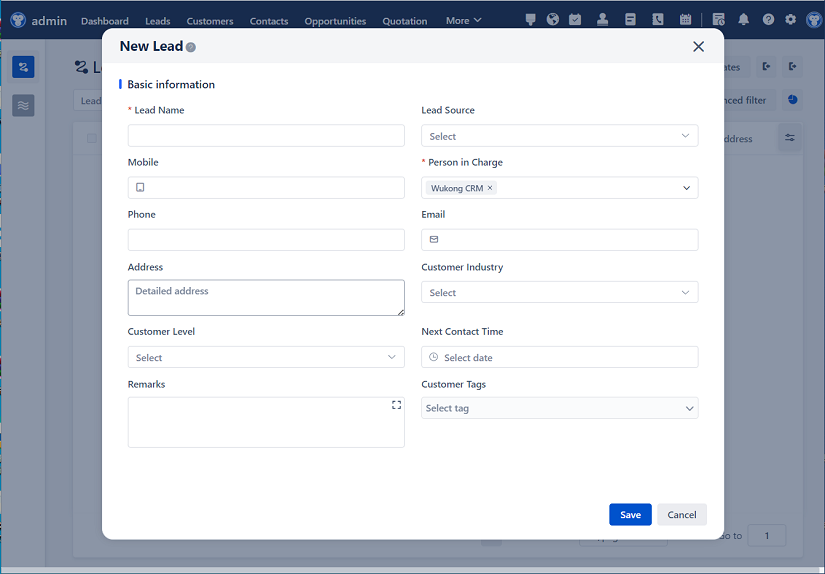
△Click on the top right corner to try Wukong CRM for free
So, you know, when we start talking about CRM systems—Customer Relationship Management tools—they’re kind of like the backbone of how businesses keep track of their customers these days. I mean, think about it: whether you're running a small online store or managing a huge sales team across multiple countries, having a solid CRM can make or break your customer interactions. But here’s the thing—everyone wants to know: how much does it actually cost? Like, really, what are we looking at here?
Well, honestly, there’s no one-size-fits-all answer. The price range for CRM customer management systems can vary wildly, and that’s because so many factors come into play. I’ve looked into this quite a bit, and trust me, it’s not just about picking the cheapest option and calling it a day. You’ve got to consider what features you need, how many people will be using it, and even how your business plans to grow in the next few years.
Let me break it down for you. At the most basic level, you’ve got free CRMs. Yeah, they exist! Tools like HubSpot’s free version or Zoho CRM’s free tier. These are great if you’re just starting out, maybe running a side hustle or managing a tiny team. They give you core features—contact management, basic lead tracking, maybe some email integration. But—and this is a big but—they come with limitations. You’re usually capped on the number of contacts, automation features are minimal, and support might be limited to community forums or FAQs.
Now, once you move past the free options, things start getting more interesting—and more expensive. Most mid-tier CRMs fall somewhere between
But let’s say your business is growing fast. Maybe you’ve got a sales team of 20 people, and you’re dealing with hundreds of leads every week. Suddenly, those basic tools don’t cut it anymore. That’s when you start looking at enterprise-level CRMs. And wow, do the prices jump. We’re talking
I should mention, though, that with higher-end CRMs, you’re not just paying for the software. A lot of that cost goes toward implementation, training, and ongoing support. Setting up an enterprise CRM isn’t something you do in a weekend. It often requires consultants, data migration specialists, and dedicated IT staff. So when someone says “it costs $200 per user,” that’s just the license fee. The real total cost of ownership can be two or three times that over the first year.
Another thing people often overlook is scalability. Let’s say you pick a CRM at

And speaking of features, that’s a huge driver of price differences. Basic contact storage? Cheap. Automated lead scoring based on behavior? More expensive. Real-time collaboration tools, territory management, forecasting, custom dashboards? Those bump the price up fast. Some CRMs charge extra for add-ons like telephony, marketing automation, or social media integration. So always read the fine print. I’ve seen companies get shocked by surprise fees after going live.
Deployment method matters too. Most modern CRMs are cloud-based (SaaS), which means you pay a monthly subscription and access everything online. That’s usually the most flexible and cost-effective option, especially for smaller teams. But some larger organizations still prefer on-premise solutions—where the software runs on their own servers. Those have much higher upfront costs: licensing fees, server hardware, installation, maintenance. But they offer more control and security, which some industries (like finance or healthcare) really care about.
Integration capabilities also affect pricing. If your CRM needs to talk to your ERP, accounting software, e-commerce platform, or helpdesk tool, that adds complexity. Some CRMs include common integrations for free; others charge per integration or require third-party tools like Zapier. And if you need custom API development? That’s another line item on the bill.
Then there’s the vendor. Big names like Salesforce or Oracle naturally command premium prices—not just because their software is powerful, but because of brand reputation, global support networks, and extensive ecosystems. Smaller vendors might offer similar functionality at lower prices, but you could sacrifice reliability or long-term support. It’s a trade-off.
User count is obviously a major factor. Most CRMs price per user, per month. But what counts as a “user”? Is it anyone who logs in? Or only active sellers? Some vendors charge differently for different roles—like full-access users vs. read-only users. That can help you save money if not everyone needs full functionality.
Implementation time and training also influence overall cost. A simple CRM might take a week to set up. A complex one? Months. During that time, your team might be less productive, and you’re probably paying consultants by the hour. Training materials, webinars, and ongoing support—all of that adds up. Don’t forget internal time either. Your employees aren’t free, and pulling them away from their regular work to learn a new system has a real cost.
Now, here’s something people don’t talk about enough: hidden costs. Things like data storage overages, transaction fees, or charges for exporting your data. Some CRMs limit how much data you can store or how many emails you can send through the system. Exceed those limits? Extra fees. And if you ever decide to switch providers, getting your data out might cost you—sometimes hundreds of dollars.
Support levels vary widely too. Free or low-cost CRMs might only offer email support during business hours. Higher-tier plans include 24/7 phone support, dedicated account managers, or even SLAs (service level agreements) guaranteeing response times. For mission-critical operations, that peace of mind is worth paying for.
Customization is another big one. Off-the-shelf CRMs work well for standard processes. But if your sales cycle is unique, or you need industry-specific fields and workflows, you’ll likely need customization. That means developers, configuration time, and possibly ongoing maintenance. Again, more cost.

Mobile access is pretty standard now, but some CRMs charge extra for advanced mobile features or offline mode. If your team is on the road a lot, that could be a dealbreaker.
And let’s not forget updates. With SaaS CRMs, updates are usually included—vendors roll out new features automatically. But with on-premise systems, you might have to pay for upgrades every few years. That’s another budget consideration.
So, putting it all together, how do you choose? Well, first, figure out what you actually need. Don’t pay for features you won’t use. Start small if you can, and scale as you grow. Take advantage of free trials—most vendors offer 14 to 30-day trials. Use that time to test drive the system with your team, import sample data, and see how it feels.

Also, talk to real users. Check review sites like G2, Capterra, or TrustRadius. Read both the glowing reviews and the complaints. Look for patterns. If multiple people mention slow performance or poor support, that’s a red flag.
And don’t be afraid to negotiate. Especially if you’re committing to a multi-year contract or buying licenses for dozens of users, vendors are often willing to discount the price or throw in free training or support.
Finally, remember that the cheapest option isn’t always the best value. A slightly more expensive CRM that saves your team hours every week or helps close more deals could pay for itself many times over. On the flip side, overspending on a bloated system you don’t fully use is just throwing money away.
At the end of the day, CRM pricing isn’t just about dollars and cents. It’s about fit, usability, and long-term strategy. Spend time upfront understanding your needs, involve your team in the decision, and think about where you want to be in three years—not just where you are today.
FAQs (Frequently Asked Questions):
Q: Can I really run a business without a CRM?
A: Sure, especially if you’re very small or just starting out. But as soon as you start juggling more than a handful of customers, spreadsheets get messy fast. A CRM helps you stay organized, follow up consistently, and spot trends in your sales process.
Q: Are free CRMs good enough?
A: For solopreneurs or micro-businesses, absolutely. They give you a taste of automation and organization without spending a dime. But if you’re planning to scale, you’ll likely hit limitations sooner rather than later.

Q: Why do CRM prices vary so much?
A: It’s all about features, scalability, support, and brand. Think of it like cars—a compact hatchback gets you from point A to B, but an SUV with navigation, leather seats, and safety tech costs way more because it does way more.
Q: Should I go with a well-known brand or try a lesser-known CRM?
A: Big names offer reliability and strong support, but they’re pricier. Smaller vendors might offer better value and innovation, but check their financial stability and customer reviews first.
Q: How do I avoid unexpected costs?
A: Ask detailed questions before signing. Get pricing in writing. Clarify what’s included—users, storage, support, integrations, data export. Watch out for annual contracts with auto-renewals and early termination fees.
Q: Can I switch CRMs later if I change my mind?
A: Yes, but it’s not always easy. Data migration takes time and effort. Choose carefully upfront, but know that moving is possible if your needs evolve.
Q: Is it better to pay monthly or annually?
A: Annual plans usually offer a discount (10–20%), so if you’re confident in the CRM, it can save money. But monthly gives you flexibility to cancel if it’s not working out.
Q: Do all CRMs work on mobile devices?
A: Most do, but check the app quality. Some have clunky interfaces or missing features compared to the desktop version. If your team works remotely, test the mobile experience thoroughly.
Q: What’s the average ROI of a CRM?
A: Studies show businesses often see a 2x to 5x return—through increased sales, better customer retention, and time saved on admin tasks. But ROI depends on how well you use the system.
Q: How long does it take to implement a CRM?
A: Simple ones? A few days to a couple of weeks. Complex systems with custom workflows and integrations? Could take months. Plan accordingly and allocate internal resources.
Related links:
Free trial of CRM
Understand CRM software
AI CRM Systems

△Click on the top right corner to try Wukong CRM for free